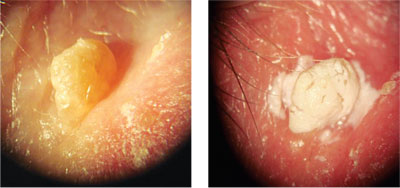 Q: I often have patients with small skin tags on their lids asking me if I can help them. Can I remove these myself?
Q: I often have patients with small skin tags on their lids asking me if I can help them. Can I remove these myself?
A: Certainly you can, as long as it’s permitted in your state, says Jeff Yunker, O.D., of Grand Forks, N.D., who’s been doing this for more than 20 years. “The procedure for removal of eyelid skin tags (papilloma or verrucae) by chemical cauterization is straightforward and easy to do,” he says. But, first check with your state board to determine whether the procedure falls within your scope of practice act.
“Skin tags are typically of viral origin and may be infectious or noninfectious. Both the infectious and noninfectious lesions are amenable to cauterization therapy,” Dr. Yunker says. “If the viral lesion is infectious, there will be multiple lesions on the eyelid because they spread as the patient rubs the lid.” Quite frequently, he adds, patients also have similar skin tags in their scapular region.
If the lesion is suspicious for a malignancy, refer the patient to an oculoplastic surgeon. “Suspect a neoplastic lesion if the tissue has had a relatively quick growth pattern or has a dark or irregular-pigmented pattern,” he says. “Papillomas have a slow growth pattern and a cauliflower-like surface that is typically the same color as the surrounding skin tissue.”
Treatment can range from no intervention, to chemical cauterization, to surgical excision. “If the patient is bothered by the growth and does not want to wait, you can apply dichloroacetic acid directly to the skin tag with a wooden applicator.” A complete kit, called Derma-Cauter-All (North Pine Enterprises, www.northpineenterprises.com), is available for just this procedure.

You can easily apply a
cauterant to a verruca, such as this one. Immediately after
application, the skin turns white. A week later, it turns black and
falls off.
“For verrucae that are closer to the lid margin, protect the normal skin near the base of the stalk by pre-treating with petroleum jelly, then apply the dichloroacetic acid,” Dr. Yunker says. “Immediately after application, the treated tissue turns white. After one week, it turns black and falls off. A second treatment is rarely necessary, but schedule a follow-up appointment at approximately one week just to ensure all is well.”
A possible side effect of the procedure is scarring, but this is not usually visible with the naked eye.
Q: Can optometrists bill for this procedure? And how do you recommend this procedure to a patient?
“We use a 99213 code for the office visit ($94) and 67850 for the destruction of the lid lesion ($294.94),” Dr. Yunker says. He also has the patient sign an Advance Beneficiary Notice of Noncoverage (ABN).
To introduce this procedure, “After the slit lamp examination, I’ll discuss the etiology of the skin tag and explain that the removal for cosmetic purposes is something that can be done in our office by a simple chemical cautery technique, and is highly effective in preventing regrowth of tissue in the same area,” Dr. Yunker says. “This procedure is well within the scope of practice for many optometrists, and is an added service your patients will be grateful that you offer.”
Neither Dr. Yunker nor Dr. Ajamian has any financial interest in the product or company mentioned.

